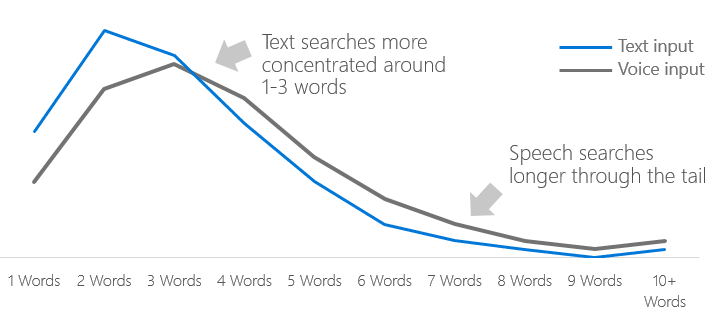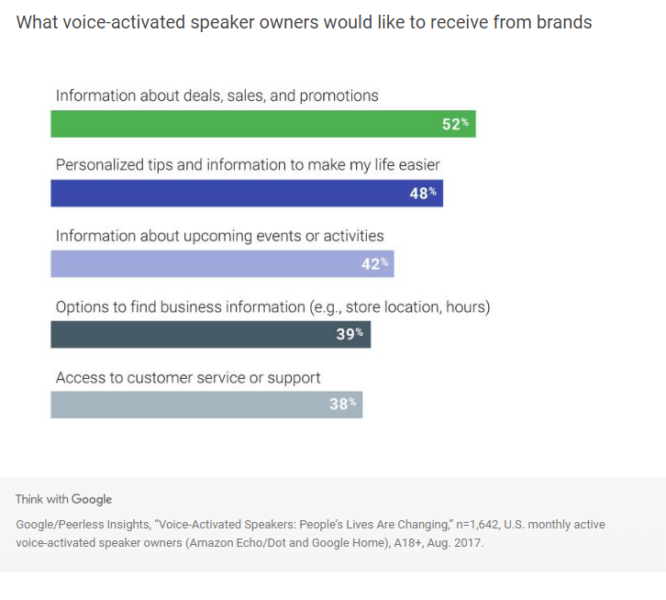
How Voice-Activated Tech Will Change Content Marketing
Once nothing more than an entertaining novelty, voice-activated technology is now big business and is fast becoming part of everyday life for many people.
There are now almost 120 million smart speaker devices in US homes (per a report by NPR and Edison Research) – a growth of 78% in just one year. The use of mobile devices has also grown. 60% of Google searches are now performed from mobile devices, and a growing percentage of those are voice searches – at least 20% according to the last figures confirmed by Google.
This evolution in the way that people are looking for and consuming information means that your content marketing strategy also needs to adapt. SEO needs a different approach when you’re optimizing for voice search, and your content does too.
Quick Takeaways:
- The way people search for information online is changing and voice searches are increasing.
- Voice searchers use different languages in their search queries.
- Users who speak are looking for different types of content – often quick answers rather than detailed articles – than those who type searches.
- Marketers must consider different methods of content delivery such as chatbots, if they want to best serve the needs of users who prefer voice-activated tech.
Why Voice Search is Different
Users of smart speakers and other voice-activated tech often have very different needs and motivations to standard web searchers on a laptop. In fact, they may not be interested in visiting your website at all – a quarter of respondents to a survey carried out in the US and Europe said they’d rather use a voice assistant than a website.
This shift in how people are using the internet might seem quite alarming to anyone who’s invested in content marketing, but there’s no need to panic. Content will continue to be a vital part of any digital marketing strategy as we move into the future, but the type of content you produce and how you optimize it will have to evolve and adapt to meet the needs of voice searchers.
According to research by Adobe, the most common uses of voice assistants are to play music, check the weather, and set alarms. After this, most users are looking for “bite-sized” information:
- Asking fun questions
- Checking news
- Asking for directions
- Checking sports scores
- Basic research
Online search also makes up a significant proportion of activities, with 47% of voice assistant users making use of this functionality. Shopping is another popular activity. While only a small percentage are using their smart speakers to actually place orders, many more are researching products, creating shopping lists, and comparing prices.
For these reasons, it’s clear that brands should look into how they can optimize for voice-activated tech users, particularly if they’re selling physical products.
Going back to online search and research, voice search users are often looking for on-the-go information and quick answers to questions such as “where’s the nearest coffee shop?” or “what time does the supermarket open?” For these queries, voice assistants tend to deliver one result only and often look in the SERPs for featured snippets rather than standard on-page content.
Voice searches are also almost always in longtail form in natural language. For these reasons, the approach to SEO is fundamentally different than traditional SEO. Rather than focusing on shorter keywords and creating long-form content, the optimal approach is to create shorter-form content with concise answers, optimized for longtail natural language queries.

It’s also important to keep your language simple when you’re writing for the machines that will parse your content when looking for answers to questions. Complex grammar and long sentences are harder for AI to understand.
Using Chatbots in Your Content Marketing Strategy
The new era of voice-activated technology may throw up some challenges for marketers, but it’s introducing some new possibilities too.
One of these possibilities is using a chatbot to help users find your content, deliver content directly to them, and to nurture leads and drive sales.
Chatbots use advanced artificial intelligence algorithms to interpret the meaning and intent of natural language queries. They can then search your content database to deliver the best content to answer the query, or answer directly with programmed responses.


Using this AI-powered software cuts down on the workload for human customer service agents and sales staff (the bot can always pass over to a human agent after initial contact or if it can’t answer the question satisfactorily). Bots are also much quicker and more effective at finding the right information than humans who have to trawl manually through a database.
To get the most out of a chatbot and integrate it properly into your content strategy, you’ll need to ensure your content is “structurally rich”. This means formatting it properly so machines can “read” it efficiently. Structurally rich content is not only useful for bots – it can also give your SEO a boost as search engines will look through your content for helpful metadata.
If you’ve not been organized in your content production so far, there will be some time investment needed to get it up to scratch. Even if you’re not planning on implementing a chatbot right now, it makes sense to create properly structured content from the current moment so you don’t need to go back and edit it at a later date.
Creating Content for Voice Assistant Users
As well as optimizing and adapting the content you produce for voice-activated technology users, it’s also important to think about the type of content to create.

It’s not just a question of long-form vs. short-form. Voice searchers often have quite different needs to text-based searchers.
Sometimes these preferences can be quite surprising. For example, you can see from the research carried out by Google above that looking for store information is a common and expected activity of users of voice-activated speakers. However information about promotions and personalized tips and information rank even higher as the types of information that these users want to receive from brands.
You can carry out your own research into what voice tech users want by surveying your users and reviewing your website analytics. However remember that many voice searchers won’t hit your site at all, instead, they’ll receive the information they’re after via featured snippets.
To discover these questions and create content to answer them, you’ll need to carry out some more in-depth keyword research in your niche.
The results of this research can help inform your content marketing plan for the coming months and years. But while a research-backed strategy is a sensible one, make room for some experimentation too.
Voice assistants are still an emerging technology and their use is likely to evolve over the next couple of years. Some people might prefer to use their smart speakers to read out long-form content rather than just answering quick questions. So it’s best to keep your content marketing plan varied (in other words don’t just rely on short-form content and featured snippets) and regularly review what is and isn’t working for you.
If you are ready to get more traffic to your site with quality content that’s consistently published, check out our Content Builder Service. Set up a quick consultation, and I’ll send you a free PDF version of my books. Get started today and generate more traffic and leads for your business.






